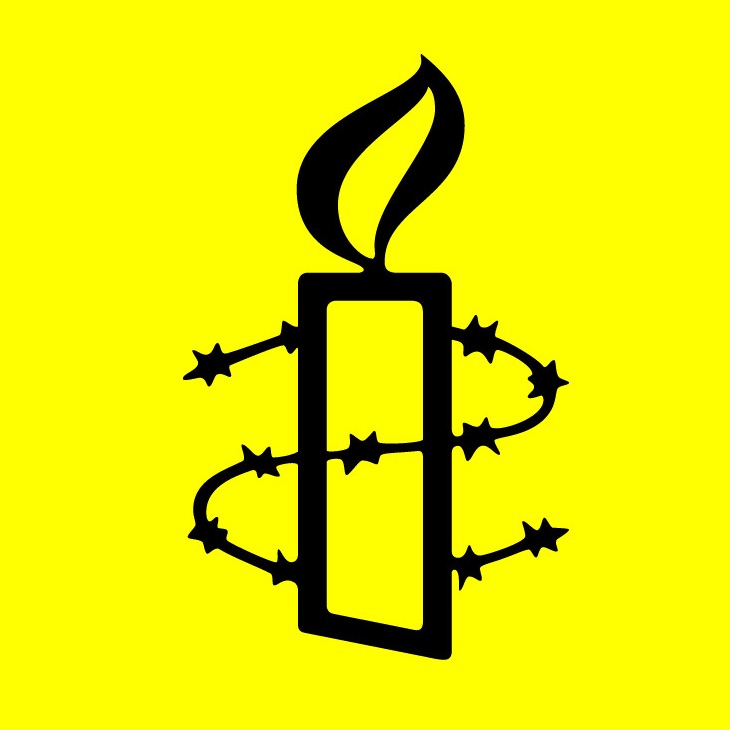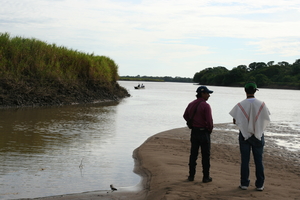The community of El Porvenir is using the Land Restitution process to fight for the legal rights to their land.©Amnesty International.
The electricity pylons stand tall but redundant, casting their long shadows along the criss-cross of dirt roads that make up the small village of Porvenir. Despite being erected months ago the pylons have not yet been connected to the main grid. But there are not many residents left to complain, many of the houses in the picturesque village stand empty, their occupants forced out by fear.
Buried deep in the forest, a two hour trip up-river from the nearest major town, Porvenir has a troubled history. A community of peasant farmers has been working and living off the land for generations and yet they are still fighting to claim legal access to the territory they rely on to graze their cattle.
The history of the town is a complex one. In the 1960s, a man named Víctor Machado claimed ownership of the land. The community continued to use the land collectively with his acquiescence until 1979 when he died, reportedly leaving some of the land to the people of El Porvenir. However in 1986 his widow sold the ‘improvements’ (mejoras) to some of the land to Víctor Carranza, one of the country’s most powerful emerald entrepreneurs. Carranza was also suspected of having close links to paramilitary groups.
Soon after the sale the killings and disappearances began.
Alejandro* is 64, his 10 children were all born in Porvenir and he was one of the first to settle in the area. “When we started we had very little, we were just 30 people,” he explains. “Before Carranza we lived without fear. But then the paramilitaries came. They were pressuring people and constantly threatening us.”
Paramilitary groups became a regular sight around the village. Then, in September 1987 the paramilitaries gathered the community together and killed 10 people all at once. After that many people left.
Since then the rightful ownership of the land has been questioned many times. In the mid-90s INCORA, a national agency tasked with adjudicating state-owned land, assigned 27 plots of the land around Porvenir to strangers- people that had never been part of the community but who allegedly had connections with Victor Carranza. Since then INCODER, the successor of the now defunct INCORA, has ordered that those land titles should be revoked. However, the land has not been given back to the Porvenir community.
The community are left waiting for those illegally on the land to leave and for the community to be granted ownership.
While the paramilitaries are no longer so visible in the area unidentified armed groups remain, and many people from the community are still afraid to return. Before the displacement nearly 400 families lived in the community. Now, only 85 families live in the town.
Alejandro stuck it out, though many of his children left. Like the majority of the villagers he relies on the land for his survival. He now works growing maize, bananas and yucca to feed his family.
“I want to work,” Alejandro says eagerly, shuffling his bare-feet in the dusty earth below, “but I don’t have a place to do it.”
Colombia’s internal armed conflict has been marked by widespread, systematic abuses of human rights and violations of the laws governing armed conflicts. Those violations include wilful killings, enforced disappearance, torture, forced displacement, abductions and crimes of sexual violence. These have been committed by the security forces and paramilitaries, either acting alone or in collusion with each other, as well as by guerrilla groups.
As a result, the country has one of the highest levels of forced displacement in the world. Nearly six million people have been displaced as a consequence of the armed conflict – that is equivalent to 13 per cent of the entire population.
In recent years new laws have introduced methods by which people can try to reclaim their land. One such law is the Victims and Land Restitution Law (Law 1448), which came into force in 2012 but has so far only resulted in the return a tiny fraction of the eight million hectares that are thought to have been abandoned or dispossessed during the course of the Colombian conflict.
The community in Porvenir is now fighting to get the legal deeds to the land using another law, Law 160, which was introduced in 1994. However progress is slow and a bureaucratic system coupled with a lack of political will from authorities has left their case stagnating.
“The need for the land is fundamental”, says Miguel Briceño, the community’s leader. He has been instrumental in the community’s on-going attempts to get the legal rights to the land. “We need that land to be able to develop, there is no alternative, nothing else we could do to develop a future for our children.”
Indeed, life in the town has stalled. The local school, which caters for 80 students has just two staff members, and their range is limited, neither of them teaches maths for example.
“There just aren’t the teachers,” explains Rosa* who has lived most of her 40 years in the town. She’s worried her three children aren’t getting the support they need. “The teachers don’t stay because there is a lack of money and because of the fear and violence.”
It is not just the teachers that are missing. In the school there is a classroom full of laptops that sit gathering dust with no electricity to power them.
When night falls the windows of the town’s small houses flicker with candle-cast shadows and the memories of the past become hard to ignore.
“It is one thing to talk about the violence that happened but quite another to live it,” says Rosa. “That fear, it stays with you, the fear that it could happen again.”
And the threat of violence remains.
“There is no security,” explains Miguel. “We’re very isolated here, really alone. The nearest police station is in a town two hours away. So this process of trying to reclaim land, it’s scary, people are afraid.”For Miguel, fear and threats go on to this day. He is very much the voice of the community, and his calls for land have made him unpopular with some. For years he has been receiving threatening phone calls.
“They threaten me, they call and tell me to present myself to them. I think the calls come from armed groups that still operate outside the law in these parts,” says Miguel.
The threats are so bad Miguel can no longer live in Porvenir. Instead he lives in a town nearby and regularly makes the long boat trip to visit his community members.
“I’ve been fighting for this land for nine years, and if something is going to happen to someone of course it will be to the leader. But I am so deep into it that there is no way I would stop. Yes I live in fear but I am not going to stop the work,” he says defiantly.
Until authorities, including INCODER, push on with processing claims the community will continue in limbo.
“The legal framework already exists to allow communities like Porvenir to reclaim their lands, there is just a serious lack of political will and energy amongst those responsible for the task,” says Marcelo Pollack, Colombia Researcher at Amnesty International.
Like the electrify pylons that watch over the town, the infrastructure is there but the power is not. “The village is on the way to getting what it wants, the laws exist and the community is ready to work, now it is just going to take government officials to push on with the process,” says Marcelo Pollack.
“I’ve always said Porvenir could be productive [growing more crops], but right now we don’t enough space. The land we’re asking for, it is our land, it belongs to us. And a peasant farmer without land- well he’s nothing,” sighs Miguel.
*Names have been changed to protect identities.
For more information:
Colombia’s land restitution process failing those forced off their land (Report, 27 November 2014)
15 facts about Colombia’s land restitution process (Feature, 27 November 2014)


